Boyle J.A. The Cambridge History of Iran, Volume 5: The Saljuq and Mongol Periods
Подождите немного. Документ загружается.

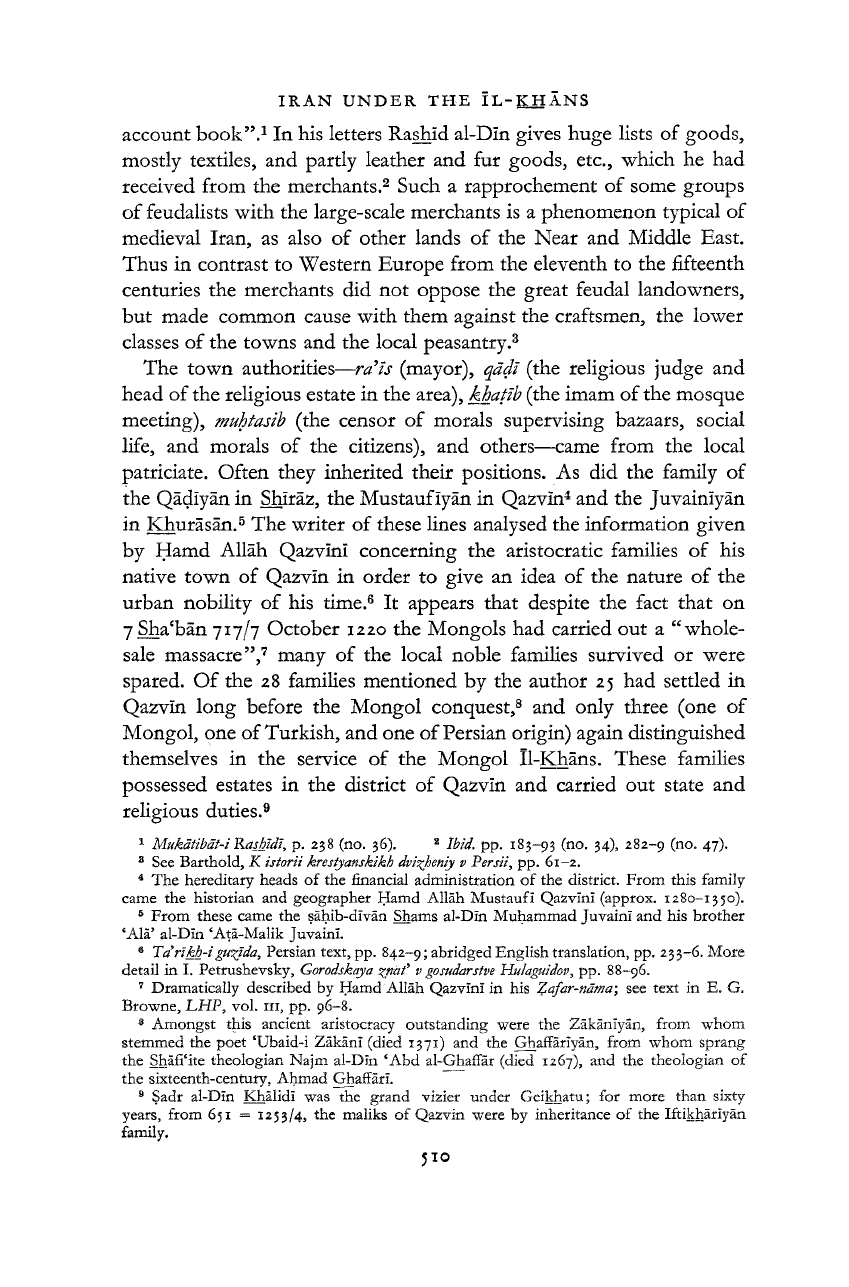
IRAN UNDER THE ÎL-KHÂNS
510
account book".
1
In his letters Rashid al-Din gives huge lists of goods,
mostly textiles, and partly leather and fur goods, etc, which he had
received from the merchants.
2
Such a rapprochement of some groups
of feudalists with the large-scale merchants is a phenomenon typical of
medieval Iran, as also of other lands of the Near and Middle East.
Thus in contrast to Western Europe from the eleventh to the fifteenth
centuries the merchants did not oppose the great feudal landowners,
but made common cause with them against the craftsmen, the lower
classes of the towns and the local peasantry.
3
The town authorities—refis (mayor), qddi (the religious judge and
head of the religious estate in the area), khatib (the imam of the mosque
meeting), muhtasib (the censor of morals supervising bazaars, social
life, and morals of the citizens), and others—came from the local
patriciate. Often they inherited their positions. As did the family of
the Qâdiyàn in Shiraz, the Mustaufiyân in Qazvin
4
and the Juvainïyàn
in Khurasan.
5
The writer of these lines analysed the information given
by Hamd Allah Qazvini concerning the aristocratic families of his
native town of Qazvin in order to give an idea of the nature of the
urban nobility of his time.
6
It appears that despite the fact that on
7 Sha'ban 717/7 October 1220 the Mongols had carried out a "whole-
sale massacre",
7
many of the local noble families survived or were
spared. Of the 28 families mentioned by the author 25 had settled in
Qazvin long before the Mongol conquest,
8
and only three (one of
Mongol, one of Turkish, and one of Persian origin) again distinguished
themselves in the service of the Mongol Il-Khàns. These families
possessed estates in the district of Qazvin and carried out state and
religious duties.
9
1
Mukâtibât-i Rashïdt, p. 238 (no. 36).
2
Ibid. pp. 183-93 (no. 34), 282-9 (no. 47).
8
See Barthold, K istorii krestyanskikh
dvi^heniy
v Persii, pp. 61-2.
4
The hereditary heads of the financial administration of the district. From this family
came the historian and geographer Hamd Allah Mustaufî Qazvïnï (approx. 12
80-1350).
5
From these came the sâhib-dïvân Shams al-Din Muhammad Juvaini and his brother
'Alà' al-Dïn 'Atà-Malik Juvaini.
6
Tarikh-igu^Jda, Persian text, pp. 842-91 abridged English translation, pp. 233-6. More
detail in I. Petrushevsky,
Gorodskaya
%naf
v
go
sudorstve
Hulaguidov,
pp. 88-96.
7
Dramatically described by Hamd Allah Qazvïnï in his Zafar-nâma; see text in E. G.
Browne, LHP, vol. in, pp. 96-8,
8
Amongst this ancient aristocracy outstanding were the Zàkânïyân, from whom
stemmed the poet 'Ubaid-i Zàkânï (died 1371) and the Ghafiarïyân, from whom sprang
the
ShàfTite theologian Najm al-Dïn 'Abd al-Ghafiar (died 1267), and the theologian of
the sixteenth-century, Ahmad Ghaffàrï.
9
Sadr al-Dïn Khàlidï was the grand vizier under Geikhatu; for more than sixty
years,
from 651 = 1253/4, the maliks of Qazvin were by inheritance of the Iftikhârïyàn
family.
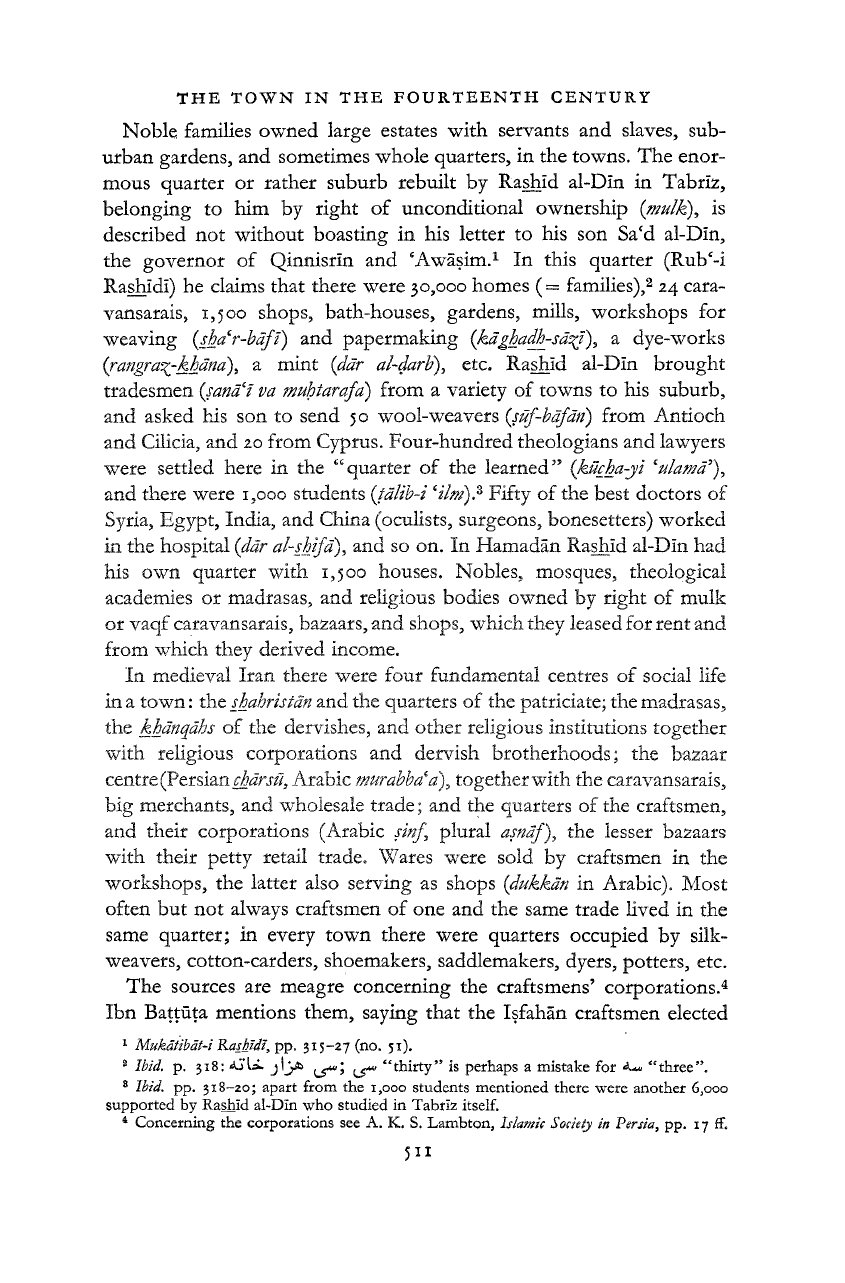
THE TOWN IN THE FOURTEENTH CENTURY
5"
Noble families owned large estates with servants and slaves, sub-
urban gardens, and sometimes whole quarters, in the towns. The enor-
mous quarter or rather suburb rebuilt by Rashid al-Din in Tabriz,
belonging to him by right of unconditional ownership {mulk), is
described not without boasting in his letter to his son Sa
c
d al-Din,
the governor of Qinnisrin and 'Awasim.
1
In this quarter (Rub'-i
Rashidi) he claims that there were 30,000 homes (= families),
2
24 cara-
vansarais, 1,500 shops, bath-houses, gardens, mills, workshops for
weaving {sha'r-bdfi) and papermaking {kdghadh-sd^i), a dye-works
{rangra^-khdna), a mint {ddr al-darb), etc. Rashid al-Din brought
tradesmen {sanai
va muhtarafd)
from a variety of towns to his suburb,
and asked his son to send 50 wool-weavers
{suf-bdfdn)
from Antioch
and Cilicia, and
20
from Cyprus. Four-hundred theologians and lawyers
were settled here in the " quarter of the learned" {kucha-ji
c
ulamd՝),
and there were 1,000 students
{tdlib֊i
Him)? Fifty of the best doctors of
Syria, Egypt, India, and China (oculists, surgeons, bonesetters) worked
in the hospital
{ddr
al-shifd), and so on. In Hamadan Rashid al-Din had
his own quarter with 1,500 houses. Nobles, mosques, theological
academies or madrasas, and religious bodies owned by right of mulk
or vaqf caravansarais, bazaars, and shops, which they leased for rent and
from which they derived income.
In medieval Iran there were four fundamental centres of social life
in a town: the
shahristdn
and the quarters of the patriciate; the madrasas,
the khdnqdhs of the dervishes, and other religious institutions together
with religious corporations and dervish brotherhoods; the bazaar
centre (Persian
chdrsu,
Arabic
murabba
c
a),
together with the caravansarais,
big merchants, and wholesale trade; and the quarters of the craftsmen,
and their corporations (Arabic
sinf,
plural asndf), the lesser bazaars
with their petty retail trade. Wares were sold by craftsmen in the
workshops, the latter also serving as shops {dukkdn in Arabic). Most
often but not always craftsmen of one and the same trade lived in the
same quarter; in every town there were quarters occupied by silk-
weavers, cotton-carders, shoemakers, saddlemakers, dyers, potters, etc.
The sources are meagre concerning the craftsmens' corporations.
4
Ibn Battuta mentions them, saying that the Isfahan craftsmen elected
1
Mukdtibdt-i Rashidi, pp. 315-27 (no. 51).
2
Ibid. p. 318: AJU. jlj^A ^«,; "thirty" is perhaps a mistake for A*« "three".
8
Ibid. pp. 318-20; apart from the 1,000 students mentioned there were another 6,000
supported by Rashid al-Din who studied in Tabriz
itself.
4
Concerning the corporations see A. K. S. Lambton, Islamic
Society
in Persia, pp. 17 ff.
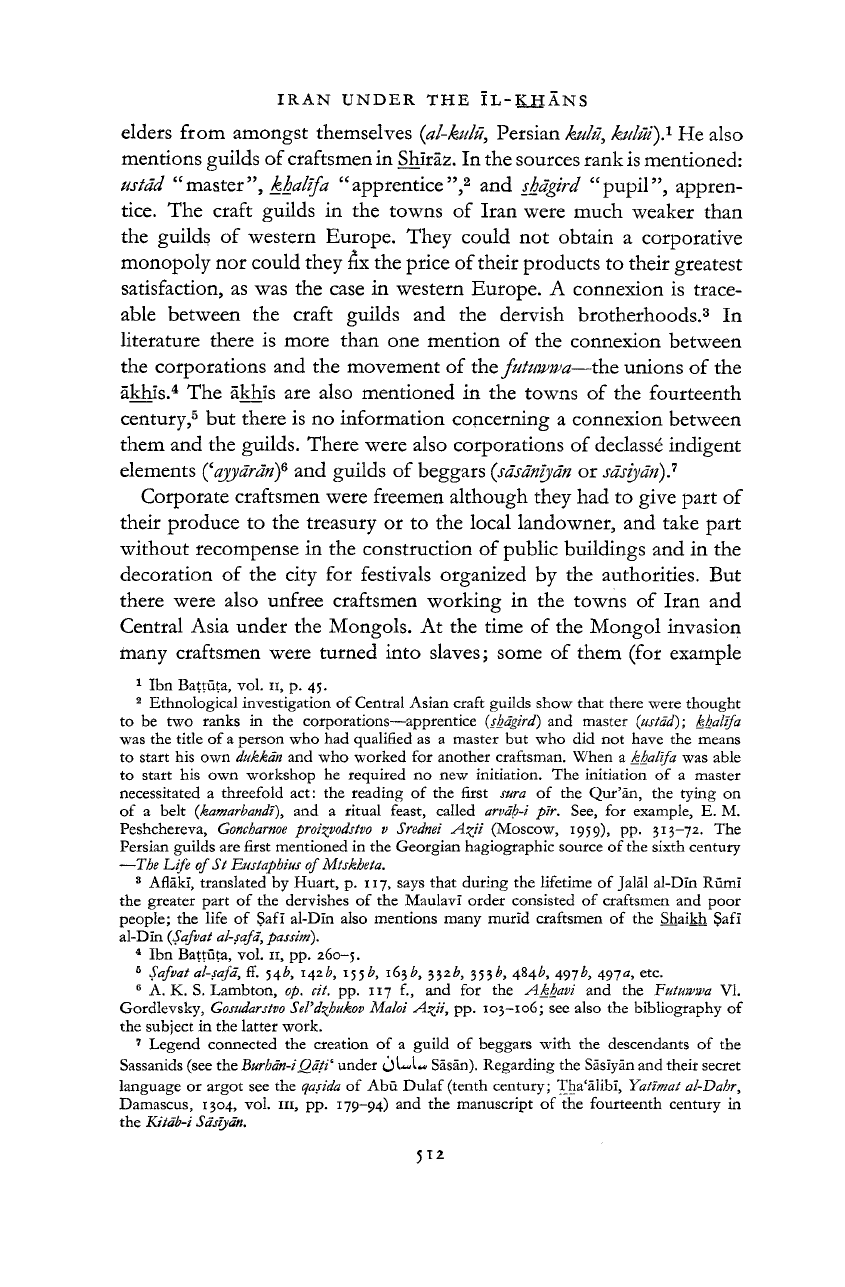
IRAN UNDER THE ÎL-KHÂNS
elders from amongst themselves (al-ku/u, Persian kulu, kului).
1
He also
mentions guilds of craftsmen in Shiraz. In the sources rank is mentioned:
ustdd "'master", khalifa "apprentice",
2
and shagird "pupil", appren-
tice. The craft guilds in the towns of Iran were much weaker than
the guilds of western Europe. They could not obtain a corporative
monopoly nor could they fix the price of their products to their greatest
satisfaction, as was the case in western Europe. A connexion is trace-
able between the craft guilds and the dervish brotherhoods.
3
In
literature there is more than one mention of the connexion between
the corporations and the movement of the futmvwa—the unions of the
akhis.
4
The akhis are also mentioned in the towns of the fourteenth
century,
5
but there is no information concerning a connexion between
them and the guilds. There were also corporations of declasse indigent
elements Najjardnf and guilds of beggars
(sdsdniydn
or sdsiydn)?
Corporate craftsmen were freemen although they had to give part of
their produce to the treasury or to the local landowner, and take part
without recompense in the construction of public buildings and in the
decoration of the city for festivals organized by the authorities. But
there were also unfree craftsmen working in the towns of Iran and
Central Asia under the Mongols. At the time of the Mongol invasion
many craftsmen were turned into slaves; some of them (for example
1
Ibn Battiita, vol. n, p. 45.
2
Ethnological investigation of Central Asian craft guilds show that there were thought
to be two ranks in the corporations—apprentice (shagird) and master {ustdd); khalifa
was the title of a person who had qualified as a master but who did not have the means
to start his own dukkan and who worked for another craftsman. When a khalifa was able
to start his own workshop he required no new initiation. The initiation of a master
necessitated a threefold act: the reading of the first sura of the Qur'an, the tying on
of a belt (kamarhandi), and a ritual feast, called arvdh-i pir. See, for example, E. M.
Peshchereva,
Goncharnoe proi^yodstvo
v Srednei A^ii (Moscow, 1959), pp. 313-72. The
Persian guilds are first mentioned in the Georgian hagiographic source of the sixth century
—The Life of St Eustaphius of Mtskheta.
3
Aflaki, translated by Huart, p. 117, says that during the lifetime of Jalal al-Dln Ruml
the greater part of the dervishes of the Maulavi order consisted of craftsmen and poor
people; the life of SafI al-DIn also mentions many murid craftsmen of the Shaikh Safi
al-DIn (Sof vat al-safd, passim).
4
Ibn Battuta, vol. 11, pp. 260-5.
5
Sof vat al-safd, ff. 54^, 142^, 155 163^, 332^, 353#> 484^, 497^, 497a, etc.
6
A. K. S. Lambton, op. cit. pp. 117 f., and for the Akhavi and the Futuwwa VI.
Gordlevsky,
Gosudarstvo SePd^hukov
Maloi
A%ii
։
pp. 103-106; see also the bibliography of
the subject in the latter work.
7
Legend connected the creation of a guild of beggars with the descendants of the
Sassanids (see the Burhdn-iQdti
1
under
oL*A<*
Sasan).
Regarding the Saslyan and their secret
language or argot see the qasida of Abu Dulaf (tenth century; Tha'alibi, Yatimat al-Dahr,
Damascus, 1304, vol. 111, pp. 179-94) and the manuscript of the fourteenth century in
the Kitdb-i
Sdsiydn.
512
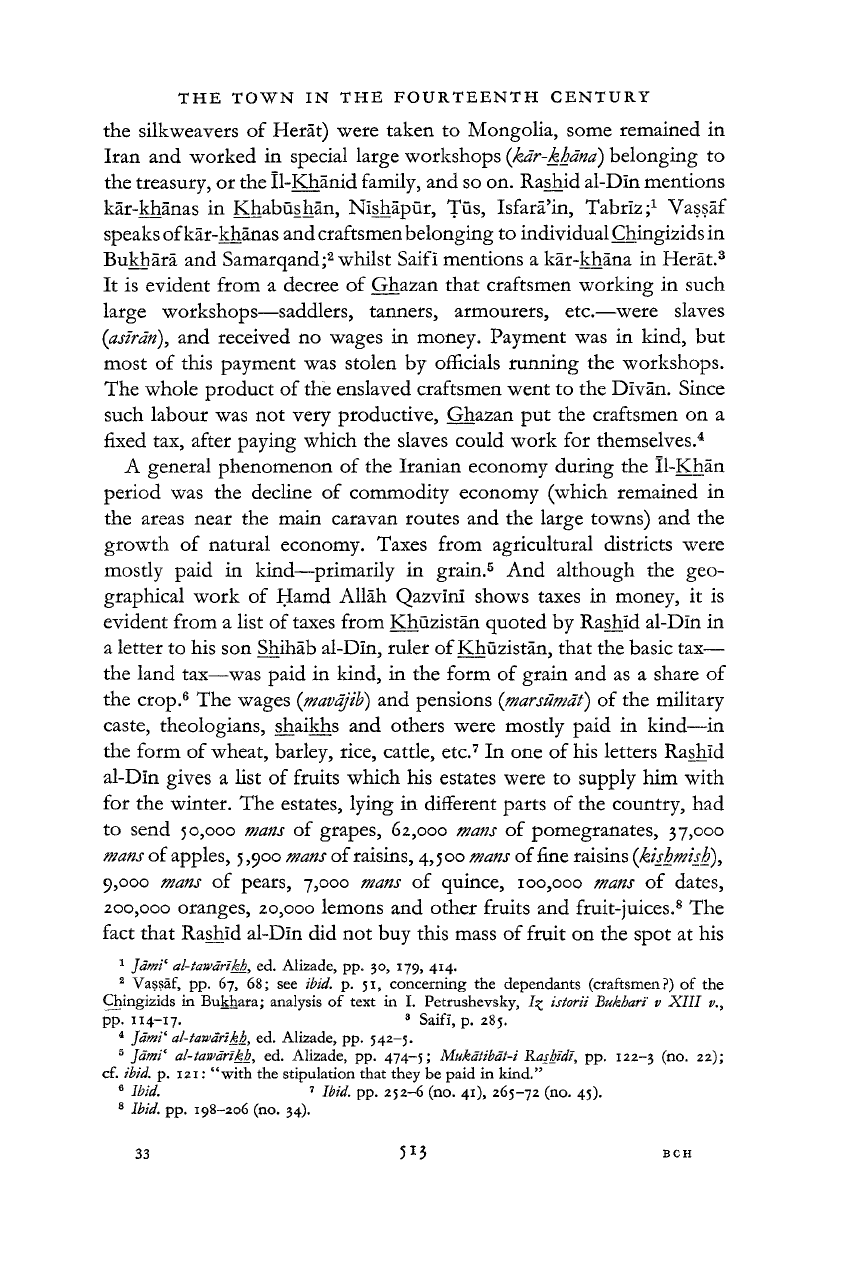
THE TOWN IN THE FOURTEENTH CENTURY
33
513
BCH
the silkweavers of Herat) were taken to Mongolia, some remained in
Iran and worked in special large workshops (kdr-khdna) belonging to
the treasury, or the Il-Khanid family, and so on. Rashid al-Dln mentions
kar-khanas in Khabushan, Nishapur, Tus, Isfara'in, Tabriz;
1
Vassaf
speaks of kar-khanas and craftsmen belonging to individual
Chingizids in
Bukhara and Samarqand;
2
whilst Saifi mentions a kar-khana in Herat.
3
It is evident from a decree of Ghazan that craftsmen working in such
large workshops—saddlers, tanners, armourers, etc.—were slaves
(asiran), and received no wages in money. Payment was in kind, but
most of this payment was stolen by officials running the workshops.
The whole product of the enslaved craftsmen went to the Divan. Since
such labour was not very productive, Ghazan put the craftsmen on a
fixed tax, after paying which the slaves could work for themselves.
4
A general phenomenon of the Iranian economy during the Il-Khan
period was the decline of commodity economy (which remained in
the areas near the main caravan routes and the large towns) and the
growth of natural economy. Taxes from agricultural districts were
mostly paid in kind—primarily in grain.
5
And although the geo-
graphical work of Hamd Allah Qazvini shows taxes in money, it is
evident from a list of taxes from Khuzistan quoted by Rashid al-Din in
a letter to his son Shihab al-Din, ruler of Khuzistan, that the basic tax—
the land tax—was paid in kind, in the form of grain and as a share of
the crop.
6
The wages
(mavajib)
and pensions
(marsumdt)
of the military
caste, theologians, shaikhs and others were mostly paid in kind—in
the form of wheat, barley, rice, cattle, etc.
7
In one of his letters Rashid
al-Din gives a list of fruits which his estates were to supply him with
for the winter. The estates, lying in different parts of the country, had
to send 50,000 mans of grapes, 62,000 mans of pomegranates, 37,000
mans
of apples, 5,900
mans
of raisins, 4,500
mans
of fine raisins (kishmish),
9,000 mans of pears, 7,000 mans of quince, 100,000 mans of dates,
200,000 oranges, 20,000 lemons and other fruits and fruit-juices.
8
The
fact that Rashid al-Din did not buy this mass of fruit on the spot at his
1
Jam? al-tawdrikh, ed. Alizade, pp. 30, 179, 414.
2
Vassaf, pp. 67, 68; see ibid. p. 51, concerning the dependants (craftsmen
?)
of the
Chingizids in Bukhara; analysis of text in I. Petrushevsky, 1% istorii Bukbari' v XIII v.,
pp.
114-17.
8
Saifi, p. 285.
4
Jdmi
(
al-tawdrikh, ed. Alizade, pp. 542-5.
5
J ami
1
al-tawdrikh
y
ed. Alizade, pp. 474-5; Mukdtibdt-i Rashldl, pp. 122-3 (no. 22);
cf. ibid. p. 121: "with the stipulation that they be paid in kind."
6
Ibid.
7
Ibid. pp. 252-6 (no. 41), 265-72 (
no
- 45)·
8
Ibid. pp. 198-206 (no. 34).
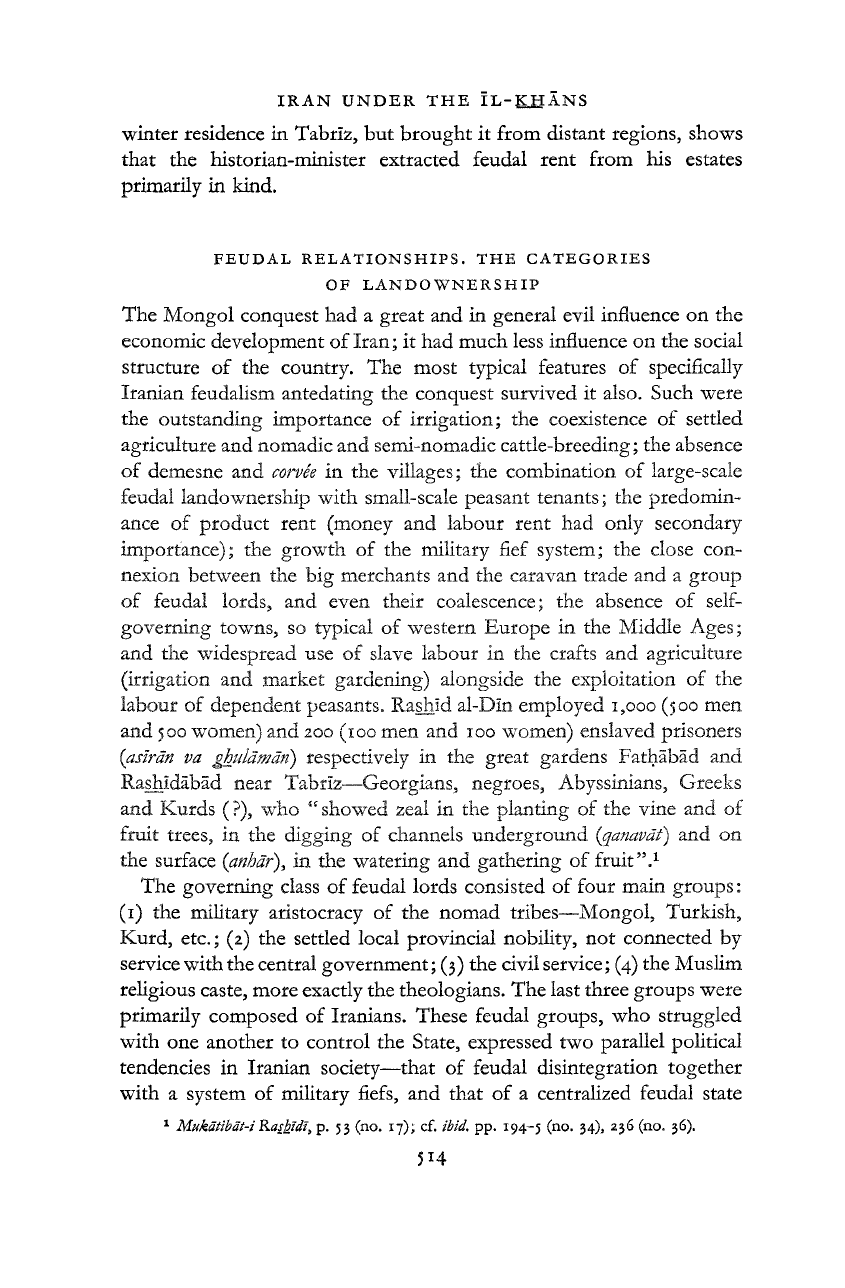
IRAN UNDER THE IL-KHANS
514
winter residence in Tabriz, but brought it from distant regions, shows
that the historian-minister extracted feudal rent from his estates
primarily in kind.
FEUDAL RELATIONSHIPS. THE CATEGORIES
OF LANDOWNERS HIP
The Mongol conquest had a great and in general evil influence on the
economic development of Iran; it had much less influence on the social
structure of the country. The most typical features of specifically
Iranian feudalism antedating the conquest survived it also. Such were
the outstanding importance of irrigation
;
the coexistence of settled
agriculture and nomadic and semi-nomadic cattle-breeding
;
the absence
of demesne and
corvée
in the villages; the combination of large-scale
feudal landownership with small-scale peasant tenants
;
the predomin-
ance of product rent (money and labour rent had only secondary
importance)
;
the growth of the military fief system
;
the close con-
nexion between the big merchants and the caravan trade and a group
of feudal lords, and even their coalescence
;
the absence of
self-
governing towns, so typical of western Europe in the Middle Ages;
and the widespread use of slave labour in the crafts and agriculture
(irrigation and market gardening) alongside the exploitation of the
labour of dependent peasants. Rashid al-Din employed 1,000
(500
men
and
500
women) and 200 (100 men and 100 women) enslaved prisoners
{astrati
va
ghulàmàrì)
respectively in the great gardens Fathabad and
Rashìdàbàd near Tabriz—Georgians, negroes, Abyssinians, Greeks
and Kurds (
?),
who " showed zeal in the planting of the vine and of
fruit trees, in the digging of channels underground
(qanavdt)
and on
the surface
(anhdr),
in the watering and gathering of fruit".
1
The governing class of feudal lords consisted of four main groups :
(1) the military aristocracy of the nomad tribes—Mongol, Turkish,
Kurd, etc. ; (2) the settled local provincial nobility, not connected by
service with the central government
;
(3) the civil service
;
(4) the Muslim
religious caste, more exactly the theologians. The last three groups were
primarily composed of Iranians. These feudal groups, who struggled
with one another to control the State, expressed two parallel political
tendencies in Iranian society—that of feudal disintegration together
with a system of military fiefs, and that of a centralized feudal state
1
Mukatibdt-i Rasbtdi, p. 53 (no. 17); cf. ibid. pp. 194-5 (no. 34), 236 (no. 36).
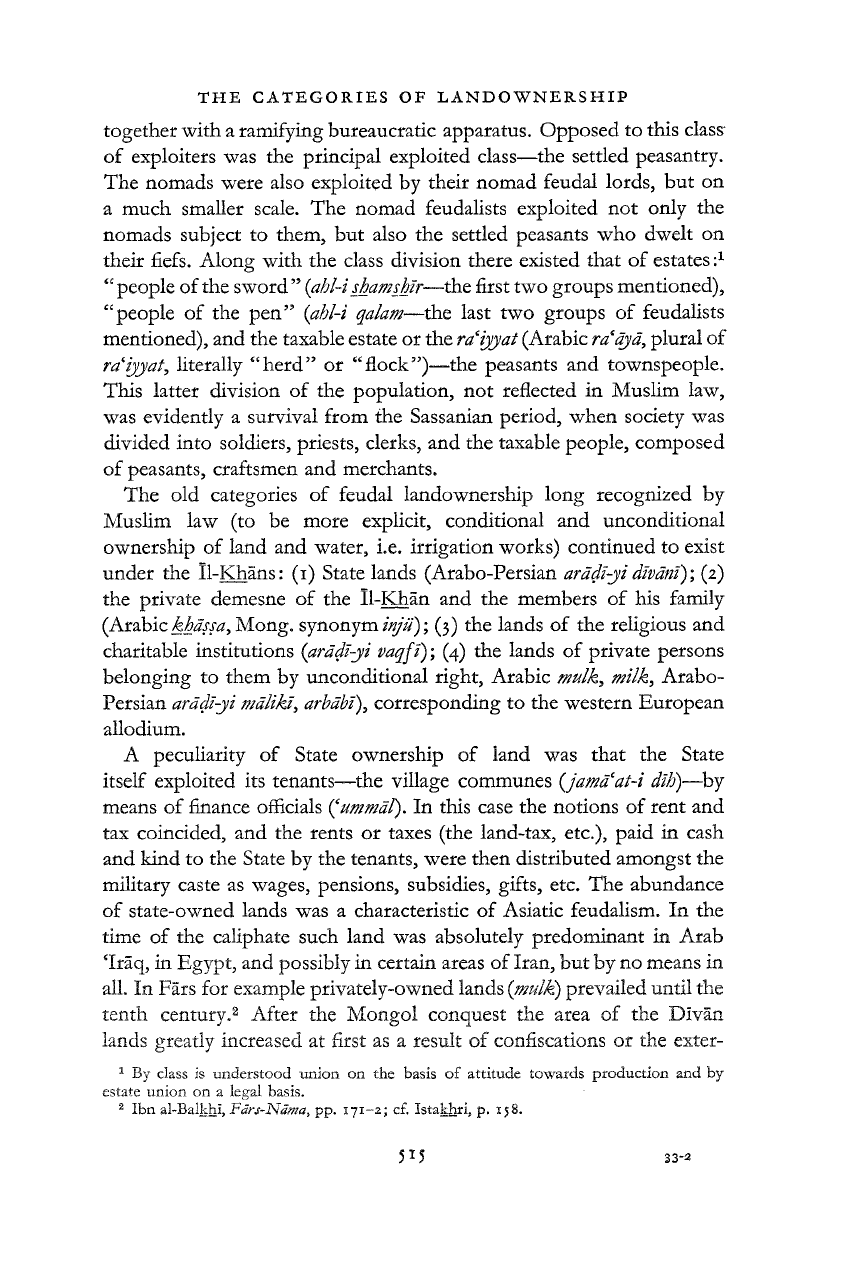
THE CATEGORIES OF LANDOWNERS HIP
together with a ramifying bureaucratic apparatus. Opposed to this class-
of exploiters was the principal exploited class—the settled peasantry.
The nomads were also exploited by their nomad feudal lords, but on
a much smaller scale. The nomad feudalists exploited not only the
nomads subject to them, but also the settled peasants who dwelt on
their fiefs. Along with the class division there existed that of estates:
1
"people of the sword" (ah l-i sham shir—the first two groups mentioned),
"people of the pen"
(ahl֊i
qalam—the last two groups of feudalists
mentioned), and the taxable estate or the
ra'iyyat
(Arabic
ra'dyd,
plural of
ra'iyyat, literally "herd" or "flock")—the peasants and townspeople.
This latter division of the population, not reflected in Muslim law,
was evidently a survival from the Sassanian period, when society was
divided into soldiers, priests, clerks, and the taxable people, composed
of peasants, craftsmen and merchants.
The old categories of feudal landownership long recognized by
Muslim law (to be more explicit, conditional and unconditional
ownership of land and water, i.e. irrigation works) continued to exist
under the Il-Khans: (i) State lands (Arabo-Persian
arddi-yi
divdni);
(2)
the private demesne of the Il-Khan and the members of his family
(Arabic khdssa, Mong. synonym inju); (3) the lands of the religious and
charitable institutions
{arddi-yi
vaqfi); (4) the lands of private persons
belonging to them by unconditional right, Arabic mulk, milk, Arabo-
Persian
arddi-yi
mdliki, arbdbi), corresponding to the western European
allodium.
A peculiarity of State ownership of land was that the State
itself exploited its tenants—the village communes (jamd
c
at~i dih)—by
means of finance officials ('ummdl). In this case the notions of rent and
tax coincided, and the rents or taxes (the land-tax, etc.), paid in cash
and kind to the State by the tenants, were then distributed amongst the
military caste as wages, pensions, subsidies, gifts, etc. The abundance
of state-owned lands was a characteristic of Asiatic feudalism. In the
time of the caliphate such land was absolutely predominant in Arab
'Iraq, in Egypt, and possibly in certain areas of Iran, but by no means in
all.
In Fars for example privately-owned lands
{mulk)
prevailed until the
tenth century.
2
After the Mongol conquest the area of the Divan
lands greatly increased at first as a result of confiscations or the exter-
1
By class is understood union on the basis of attitude towards production and by-
estate union on a legal basis.
2
Ibn al-Balkhl, Fdrs-Nama, pp. 171-2; cf. Istakhri, p. 158.
515 33-2
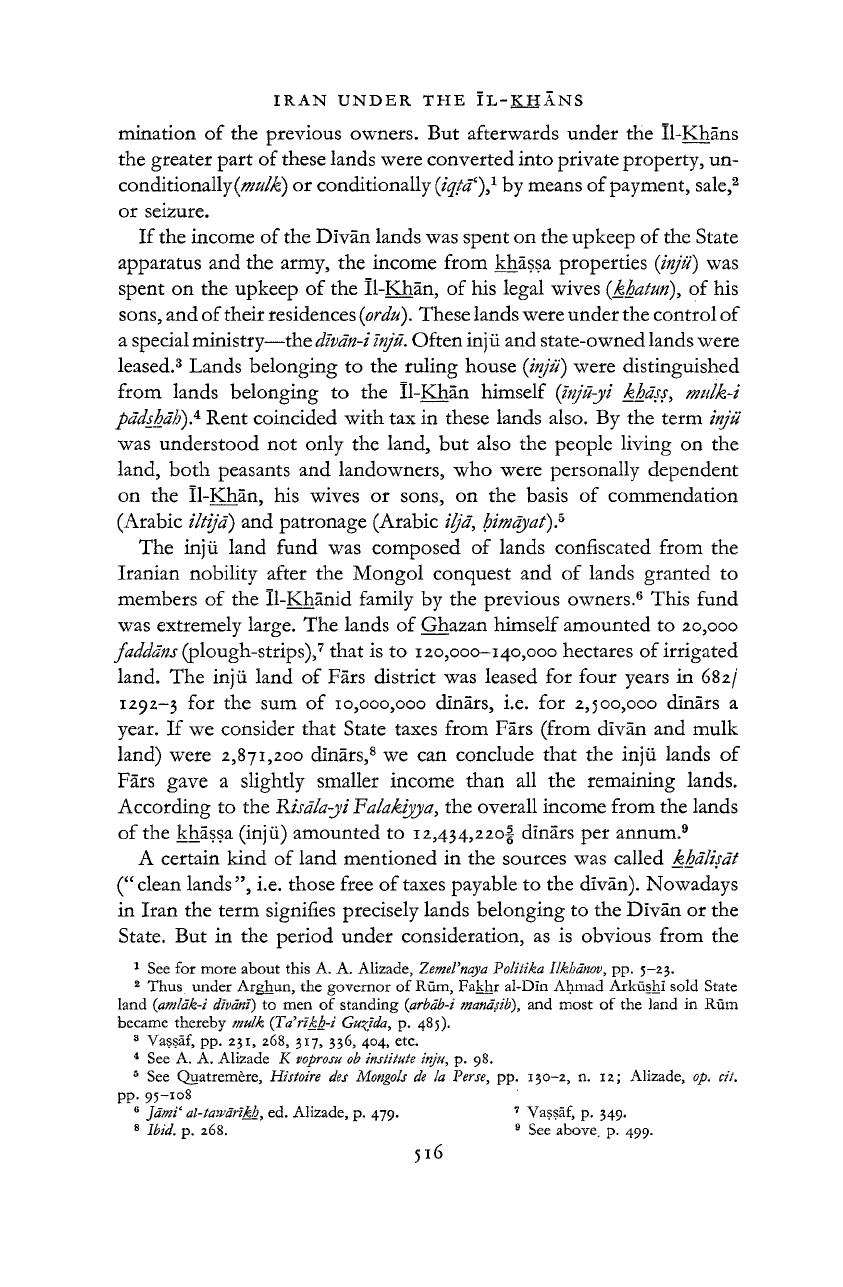
IRAN UNDER THE IL-KHÂNS
mination of the previous owners. But afterwards under the Il-Khâns
the greater part of these lands were converted into private property, un-
conditionally (mulk) or conditionally (/^Af*),
1
by means of payment, sale,
2
or seizure.
If the income of the Divân lands was spent on the upkeep of the State
apparatus and the army, the income from
khâssa properties (injü) was
spent on the upkeep of the Il-Khân, of his legal wives (khatun), of his
sons,
and of their residences
(ordu).
These lands were under the control of
a special ministry—the
divdn-i
injü.
Often injü and state-owned lands were
leased.
3
Lands belonging to the ruling house (injü) were distinguished
from lands belonging to the Il-Khan himself (ınjü-ji khdşş^
mulk֊i
pâdşhâh)* Rent coincided with tax in these lands also. By the term injü
was understood not only the land, but also the people living on the
land, both peasants and landowners, who were personally dependent
on the Il-Khan, his wives or sons, on the basis of commendation
(Arabic iltijd) and patronage (Arabic iljd, himdyaf)?
The injü land fund was composed of lands confiscated from the
Iranian nobility after the Mongol conquest and of lands granted to
members of the Il-Khanid family by the previous owners.
6
This fund
was extremely large. The lands of Ghazan himself amounted to 20,000
fadddns (plough-strips),
7
that is to 120,000-140,000 hectares of irrigated
land. The injü land of Fars district was leased for four years in 682/
1292-3 for the sum of 10,000,000 dinars, i.e. for 2,500,000 dinars a
year. If we consider that State taxes from
Fars (from divân and mulk
land) were 2,871,200 dinars,
8
we can conclude that the injü lands of
Fars gave a slightly smaller income than all the remaining lands.
According to the Risd/a-ji
Fa/akiyya,
the overall income from the lands
of the khâşşa (injü) amounted to 12,434,220i dinars per annum.
9
A certain kind of land mentioned in the sources was called khdlişdt
(" clean lands ", i.e. those free of taxes payable to the divân). Nowadays
in Iran the term signifies precisely lands belonging to the
Divân or the
State. But in the period under consideration, as is obvious from the
1
See for more about this A. A. Alizade,
ZemeVnaya
Politika Ilkbânov, pp. 5-23.
2
Thus under Arghun, the governor of Rüm, Fakhr al-DIn Ahmad Arküşhî sold State
land (amlâk-i divâni) to men of standing (arbâb-i mandşib), and most of the land in Rüm
became thereby mulk (Ta'rikh-i Gu^Jda, p. 485).
3
Vaşşâf, pp. 231, 268, 317, 336, 404, etc.
4
See A. A. Alizade K
voprosu
ob institute inju, p. 98.
5
See Quatremere, Histoire des Mongols de la Perse, pp. 130-2, n. 12; Alizade, op. cit.
pp.
95-108
6
J ami' al-tawarikh, ed. Alizade, p. 479.
7
Vaşşâf, p. 349.
8
Ibid. p. 268.
9
See above p. 499.
5x6
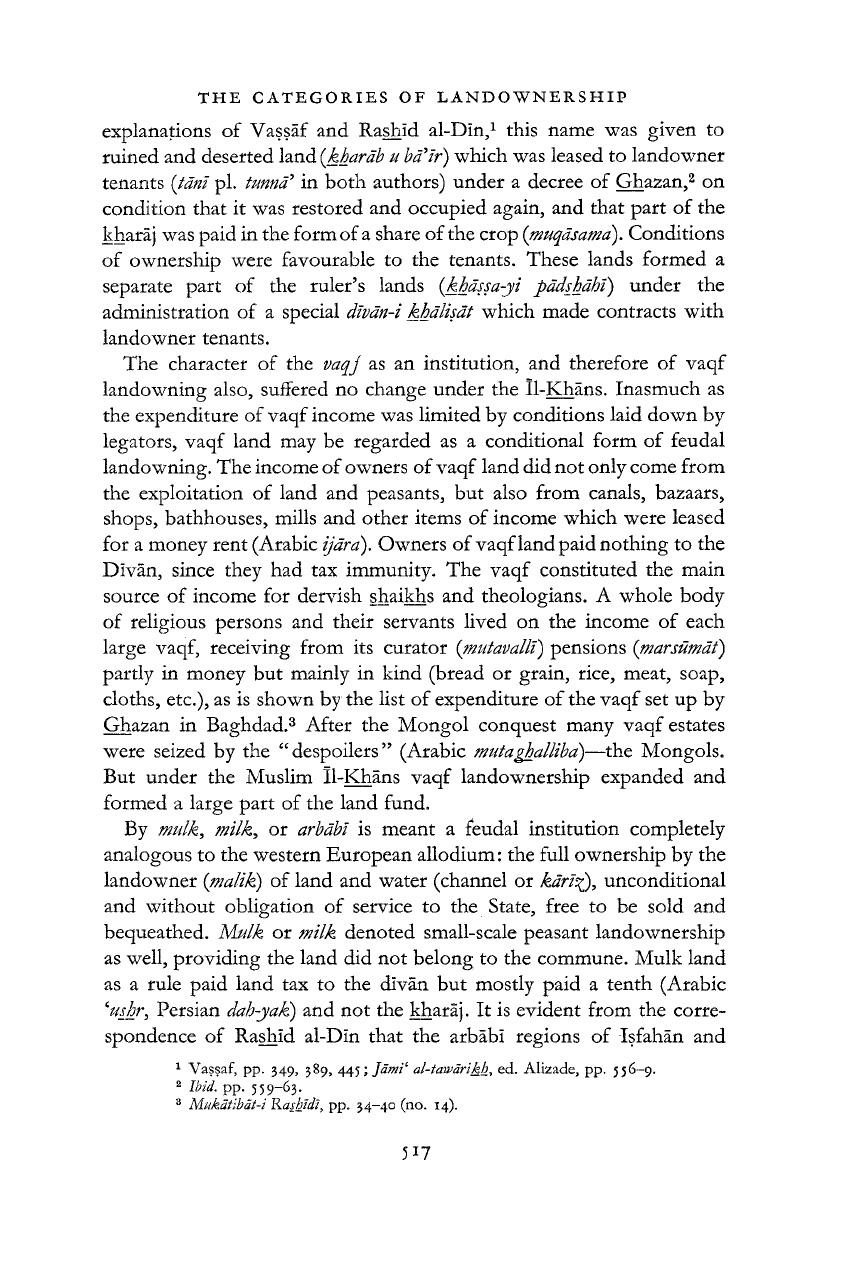
THE CATEGORIES OF LANDOWNERSHIP
517
explanations of Vaşşâf and Raşhld al-Din,
1
this name was given to
ruined and deserted land (khardb u bd'ir) which was leased to landowner
tenants
{tarn
pi.
tunnd*
in both authors) under a decree of Ghazan,
2
on
condition that it was restored and occupied again, and that part of the
kharâj was paid in the form of
a
share of the crop
(muqdsamd).
Conditions
of ownership were favourable to the tenants. These lands formed a
separate part of the ruler's lands
(khdşşa-ji pddşhdhı) under the
administration of a special dîvân-i khdlisdt which made contracts with
landowner tenants.
The character of the vaqj as an institution, and therefore of vaqf
landowning also, suffered no change under the Il-Khans. Inasmuch as
the expenditure of vaqf income was limited by conditions laid down by
legators, vaqf land may be regarded as a conditional form of feudal
landowning. The income of owners of vaqf land did not only come from
the exploitation of land and peasants, but also from canals, bazaars,
shops, bathhouses, mills and other items of income which were leased
for a money rent (Arabic
i/'dra).
Owners of vaqf land paid nothing to the
Divân, since they had tax immunity. The vaqf constituted the main
source of income for dervish shaikhs and theologians. A whole body
of religious persons and their servants lived on the income of each
large
vaqf,
receiving from its curator
{mutavallî)
pensions
(marsümdt)
partly in money but mainly in kind (bread or grain, rice, meat, soap,
cloths, etc.), as is shown by the list of expenditure of the vaqf set up by
Ghazan in Baghdad.
3
After the Mongol conquest many vaqf estates
were seized by the " despoilers " (Arabic mutaghallibd)—the Mongols.
But under the Muslim
Il-Khâns vaqf landownership expanded and
formed a large part of the land fund.
By mulk, milk, or arbdbl is meant a feudal institution completely
analogous to the western European allodium: the full ownership by the
landowner
(malik) of land and water (channel or kdri^), unconditional
and without obligation of service to the State, free to be sold and
bequeathed. Mulk or milk denoted small-scale peasant landownership
as well, providing the land did not belong to the commune. Mulk land
as a rule paid land tax to the
divân but mostly paid a tenth (Arabic
'ushr, Persian dah-jak) and not the
kharâj. It is evident from the corre-
spondence of Raşhid al-Din that the arbabi regions of Isfahan and
1
Vaşşaf, pp. 349, 389, 445; J dm i
6
al-tawdrikh, ed. Alizade, pp.
5 5
6-9.
2
Ibid. pp. 559-63.
3
Mukâtibât-i Raşhldî, pp. 34-40 (no. 14).
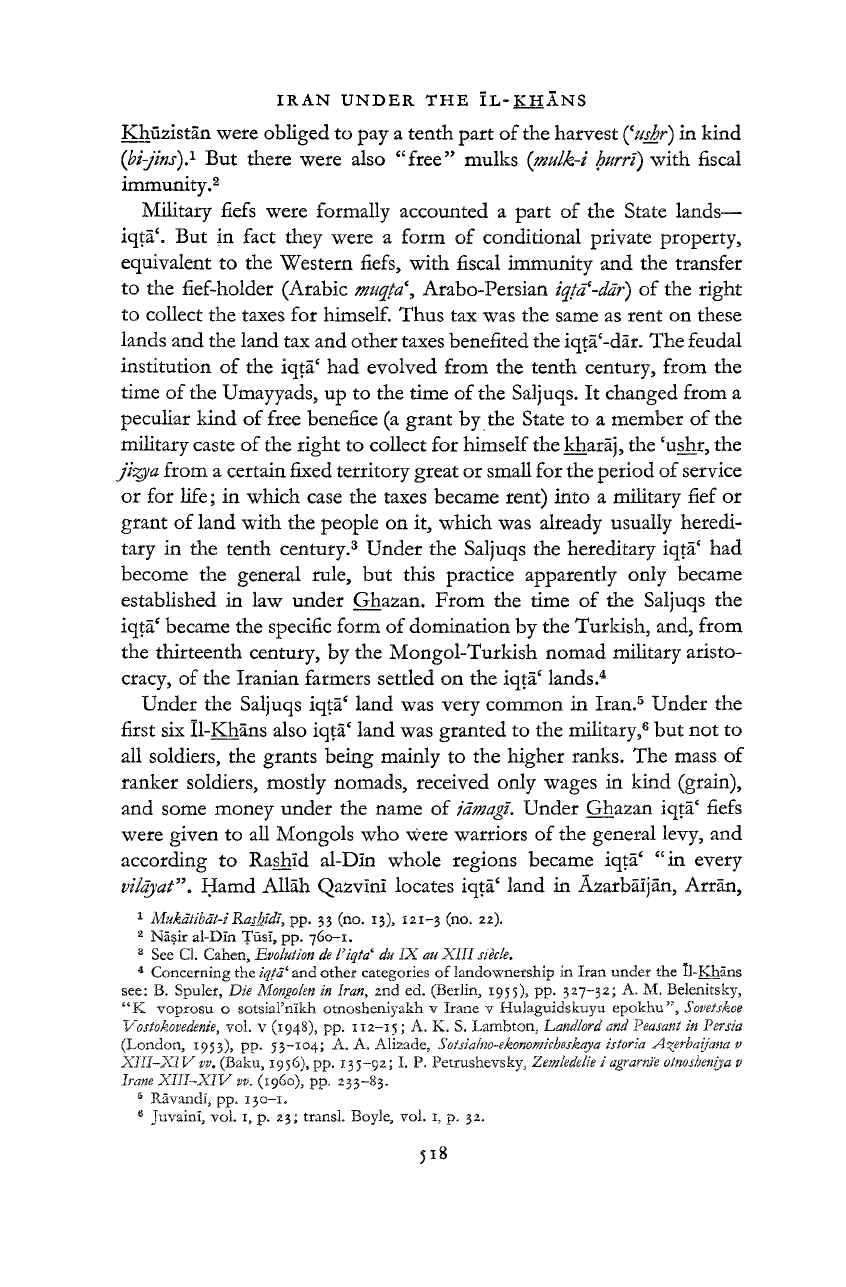
IRAN UNDER THE ÎL- KHANS
518
Khûzistân were obliged to pay a tenth part of the harvest Çuşhf) in kind
{bi-jins).
1
But there were also "free" mulks (mulk-i hum) with fiscal
immunity.
2
Military fiefs were formally accounted a part of the State lands—
iqta
c
. But in fact they were a form of conditional private property,
equivalent to the Western fiefs, with fiscal immunity and the transfer
to the fief-holder (Arabic muqta\ Arabo-Persian iqta'-dar) of the right
to collect the taxes for himself. Thus tax was the same as rent on these
lands and the land tax and other taxes benefited the iqtâ'-dâr. The feudal
institution of the iqta
c
had evolved from the tenth century, from the
time of the Umayyads, up to the time of the Saljuqs. It changed from a
peculiar kind of free benefice (a grant by the State to a member of the
military caste of the right to collect for himself the kharâj, the
c
uşhr, the
jizya from a certain fixed territory great or small for the period of service
or for life; in which case the taxes became rent) into a military fief or
grant of land with the people on it, which was already usually heredi-
tary in the tenth century.
3
Under the Saljuqs the hereditary iqta
c
had
become the general rule, but this practice apparently only became
established in law under Ghazan. From the time of the Saljuqs the
iqta' became the specific form of domination by the Turkish, and, from
the thirteenth century, by the Mongol-Turkish nomad military aristo-
cracy, of the Iranian farmers settled on the iqta' lands.
4
Under the Saljuqs iqta' land was very common in Iran.
5
Under the
first six Il-Khans also iqtâ
c
land was granted to the military,
6
but not to
all soldiers, the grants being mainly to the higher ranks. The mass of
ranker soldiers, mostly nomads, received only wages in kind (grain),
and some money under the name of
jâmagu
Under Ghazan iqta* fiefs
were given to all Mongols who were warriors of the general levy, and
according to Raşhîd al-Dln whole regions became iqta' "in every
vilâyat". Hamd Allah Qazvinl locates iqta' land in Âzarbâljân, Arrân,
1
Mukâtibât-i
RaşMdz,
pp. 33 (no. 13), 121-3 (no. 22).
2
Naşir al-Din Tüsî, pp. 760-1.
3
See CI. Cahen, Evolution
de
I'iqta' du IX au XIII
siecle.
4
Concerning the iqtâ
i
and other categories of landownership in Iran under the Il-Khâns
see: B. Spuler, Die
Mongolen
in Iran, 2nd ed. (Berlin, 1955), pp. 327-32; A. M. Belenitsky,
"K voprosu o sotsial'nikh otnosheniyakh v Irane v Hulaguidskuyu epokhu", Sovetskoe
Vostokovedenie,
vol. v (1948), pp. 112-15; A. K. S. Lambton, Landlord and Peasant in Persia
(London, 1953), pp. 53-104; A. A. Alizade,
Sotsialno-ekonomicheskaya
istoria A^erbaijana v
XIII-X1V
vv.
(Baku, 1956), pp. 135-92; I. P. Petrushevsky,
Zemledelie
i
agrarni'e otnosheniya
v
Irane
XTII-XIV
vv.
(i960), pp. 233-83.
5
Havandı, pp. 130-1.
6
Juvaini, vol. 1, p. 23; transl. Boyle, vol. 1, p. 32.
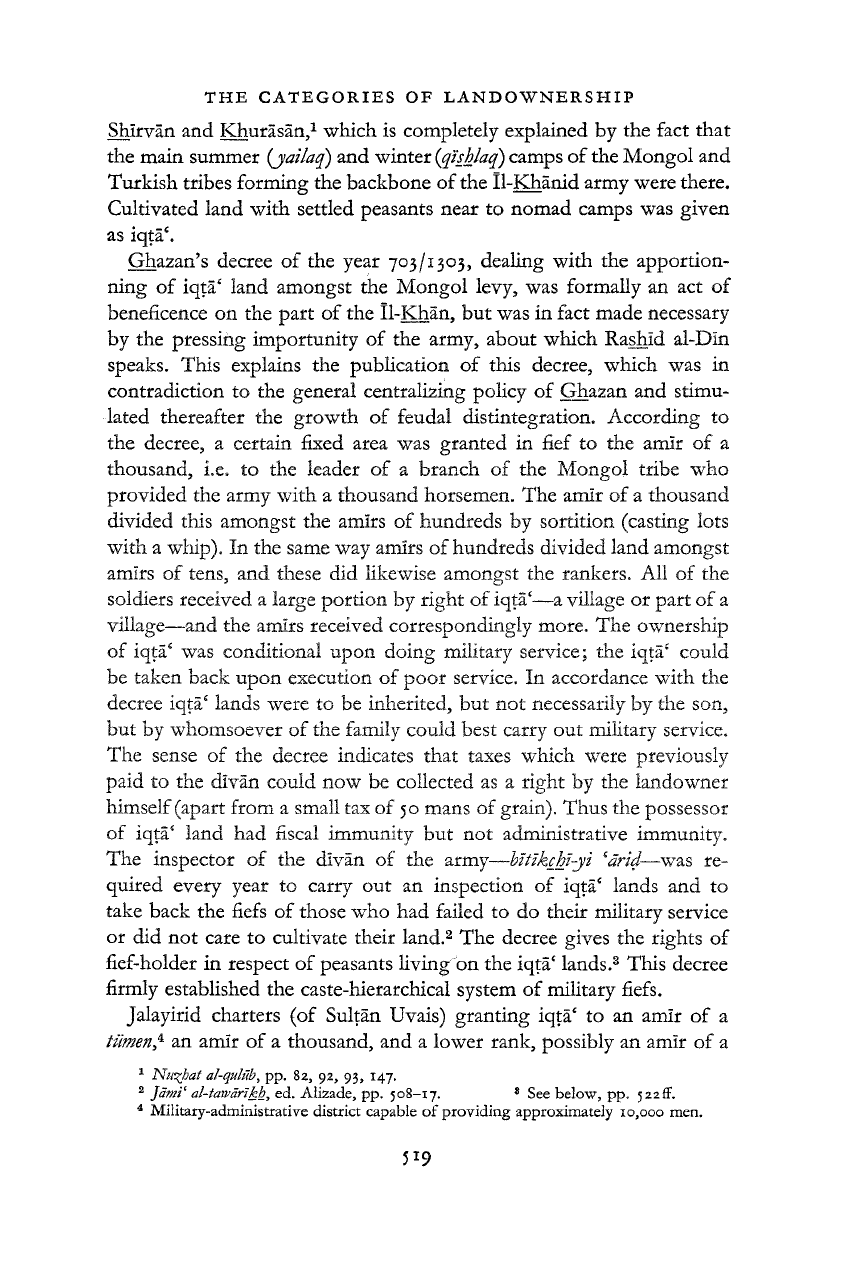
THE CATEGORIES OF LAND OWNER SHIP
519
Shirvan and Khurasan,
1
which is completely explained by the fact that
the main summer (jailaq) and winter
(qi'shlaq)
camps of the Mongol and
Turkish tribes forming the backbone of the Il-Khanid army were there.
Cultivated land with settled peasants near to nomad camps was given
as iqta'.
Ghazan's decree of the year 703/1303, dealing with the apportion-
ing of iqta' land amongst the Mongol levy, was formally an act of
beneficence on the part of the Il-Khan, but was in fact made necessary
by the pressing importunity of the army, about which Rashid al-Dln
speaks. This explains the publication of this decree, which was in
contradiction to the general centralizing policy of Ghazan and stimu-
lated thereafter the growth of feudal distintegration. According to
the decree, a certain fixed area was granted in fief to the amir of a
thousand, i.e. to the leader of a branch of the Mongol tribe who
provided the army with a thousand horsemen. The amir of a thousand
divided this amongst the amirs of hundreds by sortition (casting lots
with a whip). In the same way amirs of hundreds divided land amongst
amirs of tens, and these did likewise amongst the rankers. All of the
soldiers received a large portion by right of iqta
c
—a village or part of a
village—and the amirs received correspondingly more. The ownership
of iqta
c
was conditional upon doing military service; the iqta
c
could
be taken back upon execution of poor service. In accordance with the
decree iqta
c
lands were to be inherited, but not necessarily by the son,
but by whomsoever of the family could best carry out military service.
The sense of the decree indicates that taxes which were previously
paid to the divan could now be collected as a right by the landowner
himself (apart from a small tax of 50 mans of grain). Thus the possessor
of iqta' land had fiscal immunity but not administrative immunity.
The inspector of the divan of the army—bttikchi-yi 'arid—was re-
quired every year to carry out an inspection of iqta
c
lands and to
take back the fiefs of those who had failed to do their military service
or did not care to cultivate their land.
2
The decree gives the rights of
fief-holder in respect of peasants living on the iqta
c
lands.
3
This decree
firmly established the caste-hierarchical system of military fiefs.
Jalayirid charters (of Sultan Uvais) granting iqta' to an amir of a
tiimen? an amir of a thousand, and a lower rank, possibly an amir of a
1
Nu^hat al-qulub, pp. 82, 92, 93, 147.
2
]dmi
i
al-taivdrikh, ed. Alizade, pp. 508-17.
8
See below, pp. 522$.
4
Military-administrative district capable of providing approximately 10,000 men.
